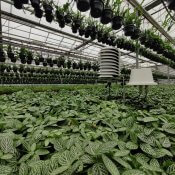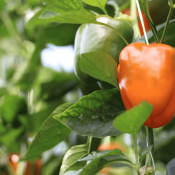Sensory data makes pest management smarter, and more cost-effective
The 30MHz team is constantly discovering new applications of sensory data across horticulture and agriculture. Customers are using live and historical data— captured predominantly by wireless sensors— to make better decisions increasing productivity, reducing waste, refocusing and optimizing manpower, saving resources and improving yield quality. The 30MHz agri-data platform provides a quick and precise feedback loop, enabling growers to verify and tailor their approach to crops.
This combination of real-time and historical context on crops and their needs is proving crucial to the optimization of integrated pest management strategies. In the case of one customer, continuous monitoring of soil temperature and soil moisture with GS3 sensors was central to the creation and optimization of a successful vine weevil strategy. Because different biological controls work at different temperatures, understanding environmental conditions enabled the customer to reduce costs when deploying. There was a significant cost difference between two products. With real-time data on soil temperature, the customer could deploy a cost saving strategy (which included using until soil temperature fell below 12 C.) With notifications based on custom triggers, customers can set alerts to understand when conditions change. Immediate insights help customers make decisions quickly in response to changes in the environment or crop needs. With alerts, the customer was able to quickly decide when application could switch to Nemasys L.
The interactive visualizations, comments and project groups within the ZENSIE platform can help ensure knowledge exchange across departments and locations within the organization. Groups make it possible to share alerts within an pest management team, for a more proactive and connected IPM strategy— allowing agribusinesses to prepare for, for example, colder weather. Animated heatmaps make observing changes in temperature more tangible, visualizing fluctuations on customer-uploaded images.
Using data captured by the pointed microclimate sensor, another 30MHz customer was able to increase precision while fighting spider mites. After installing sensors in a problem area, the customer discovered that conditions were not optimum for phytoseiulus above 25C and blow 70% RH. Armed with insights, the customer implemented a series of alerts to increase application when conditions were reducing phytoseiulus productivity.
The use of granular, crop-level sensors can assist greenhouse growers in identifying when insect and disease outbreaks might occur, and confirm strategic decisions. At Newey Roundstone, growers managed to produce a number of flower batches with no signs of pansy mottle syndrome (PaMS) in a historically challenging season. With insights from monitoring plant stress and environmental conditions, screen settings and irrigation timings were manipulated to reduce leaf and air temperatures and reduce VPD peaks. Following a change in weather conditions, very strong winds (over 15 m/s) led the climate computer to shut the vents based on thresholds set to prevent weather damage. High radiation and closed vents raised the temperature and VPD dramatically. As horticultural consultant Chris Need put it, “two weeks later, we saw that PaMS had developed. From my point of view, this experience confirmed that we had been taking the right approach to prevent pansy mottle syndrome to begin with. And if we didn’t take this approach, we would see the problem. We now have evidence to back our approach: we know we need to focus on what we need to control stress, and we see that if we don’t control those factors, we’ll have a negative result, with a delay of about two weeks ”

The collection of crop-level data is especially important when using biological controls. In another customer case, insights on microclimate helped optimize a strategy to fight thrip. Thrip had caused over 30% in losses. Through real-time monitoring, the customer had discovered that RH should never fall below 63% to reduce hatch rates. With ever-evolving new insights, the customer developed a new strategy, with a new predator, and had increased confidence in biopesticide application with data. Given the number of interrelated factors determining IPM performance, precise and accurate data captured in real time, even from hard to reach places, offers great potential for the optimization of pest management.
Our customers tell us that there are three objectives in pest management: the identification of developing pest pressures, ensuring the correct timing and conditions for the use of biopesticides or predators, and the understanding of the context within which previous issues developed— to learn from and prevent future problems. Accurate, interactive real-time and historical sensory data can make a significant impact on all three.


30MHz is typing… Our extended support team is ready to chat!
At 30MHz we think it’s important that our users can use our platform in an optimal way. At times you may have questions and you would like some help from our support team. Email and our support page filled with helpful articles were your go to’s. But we thought it was time for something extra… ...Read more
New 30MHz connect casing: How we protect your tech
To make sure your dataflow is fully protected, 30MHz introduces a new connect casing: waterproof, dust proof and even resistant to hits. This special shield will last longer and ensure a reliable dataflow from the connected sensor. What does that full protection mean? That’s what we will explain in this article. Watertight: resistant to wetness ...Read more
Smart assistant at work
After the launch of the smart (AI) assistant at GreenTech, the first growers have started using this new feature. The assistant helps them gain insights from their data faster and supports daily decision-making in the greenhouse. Growers report that they use the assistant for: Calculating differences in water content throughout the day Quickly identifying trends ...Read more


